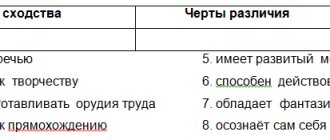a series of trainings to unite N.V. Dear class lesson on psychology (9th grade) on the topic
Training for 9th graders
Day 1
Game "I have never..."
This game will help people get to know each other better.
7-15 people participate. To play, you need chips according to the number of participants. Chips can be large beans, matches, or other small identical objects.
The first player says: "I have never...". Next he names something he has never done in his life (playing for honesty). For example:
- didn't keep cats in the house
- haven't been abroad
- didn't wear boots
- didn't shave, etc.
Let's say the player said, "I've never eaten pineapples." All players who ate pineapples must give him one chip. Then the turn goes to the other player, and he calls something that he has never done. The task of each player is to name something that he has never done, but everyone or most of those present have done.
The game ends after a certain number of laps. The one who collects the most chips wins.
Game "Secret Fairy Tale"
The victim of the prank is told that now everyone in the company will wish for one famous fairy tale. He will have to guess it by asking the company questions about the plot of the fairy tale. The whole company answers in unison (and not individually). Only answers “Yes”, “No”, “Doesn’t matter” are allowed. The game conditions seem simple to the victim, and he is removed. The company pretends that it is conceiving a fairy tale, but in reality it is agreeing on a practical joke.
In fact, no fairy tale is conceived. And the collective (in unison - necessarily) answer is based on the following principle. If the victim’s question ends with a VOWEL letter (for example, “There was a princess in this fairy tale?”), then everyone says “YES!” in unison. If the victim’s question ends with a CONSONANT (for example, “Was there a Wolf in this fairy tale?”), everyone shouts “NO!” in unison. If the question ends in “b” or “Y” (for example, “Is there Baba Yaga in this fairy tale?”), then everyone answers in unison “NOT IMPORTANT!”
An important condition is to answer in chorus synchronously. Any other comments other than these three phrases are prohibited. The victim returns to the company, and the “guessing” of the tale begins. The victim very quickly understands that the fairy tale is, to put it mildly, abnormal. But confident answers in chorus make you believe in the reality of the intended fairy tale. After 15 minutes the execution can be stopped. The pleasure from the game is indescribable. The good mood lasts for several more hours.
Organizing
Rules of conduct in class
The presenter says that these rules apply to all participants. After reading each rule, a discussion follows:
- How do you understand this rule?
- are you ready to follow it?
- The rule of activity and responsibility for everyone.
- The rule of group closure, i.e. what happens in the group is not discussed outside of it. Don’t tell others what we learn about each other in class and how different kids behave in them.
- The rule of responsibility and sincerity: you need to try to be yourself, say what you think and feel.
- Do not evaluate the behavior of group members unless they themselves ask for it.
- “Stop” rule: a group member who does not want to answer a question or participate in the game can say “Stop,” but it is advisable to use it as little as possible.
Next, the presenter “solemnly promises to follow all the rules” and invites the children to do the same.
Attention exercise:
Game "Math"
Children sit in a circle. The presenter gives the task: “Let’s start counting in a circle. The one who has a number that is a multiple of three pronounces his name instead of the number.”
This game can be used to develop memory and attention. Play and you will see that this is indeed the case.
Day 2
Game “What do we know about Vasya?”
2-5 teams of 3-10 people each play. One person is called from each team. Let's call him Vasya. The facilitator reads the questions, and the teams must answer them as accurately as possible. The answers are written on pieces of paper and handed over to the presenter (the team hands in their answer, Vasya hands in his answer, and the presenter compares). Questions could be:
- Vasya's date of birth
- What is the name of Vasya's mother?
- Who is Vasya's best friend?
- What school did Vasya go to?
- What did Vasya eat for breakfast today? etc.
Each team answers questions about their player. For the correct answer, the team is given points. The team that scores the most points wins.
WARMING UP
Warm-up “Dragon, Samurai and Girl”
Divide into two teams and stand in two lines - one team opposite the other. This is a competitive exercise. We will compete in teams. We play until any team has three winning points.
To conduct the competition we need to learn three figures. The trainer shows and the participants repeat.
Girl: The coach shifts from foot to foot, his hands seem to be holding the edges of an imaginary skirt, while pronouncing a characteristic sound: “La-la-la-la.”
Dragon: Feet shoulder-width apart, arms raised above the head, fingers spread out like claws. Characteristic aggressive sound: “A-A-A-A!!!”
Samurai: The trainer takes a fighting stance: one leg lunges forward, one arm also forward, as if the samurai were holding an imaginary sword and pointing it at the enemy. At the same time, the characteristic sound is: “U-U-U-U!!!”
Teams will be given 30 seconds to agree on which of the three figures to choose for display. After that I say: “Three-two-one!” And both teams simultaneously show the figure they have chosen. Your figures may or may not match. if they match, this round is a draw. If they do not match, then the rule applies: “Samurai kills the dragon: the team that showed the samurai earns a victory point. The dragon eats the girl: the team that showed the dragon earns a victory point. A girl seduces a samurai: the team that showed the girl earns a winning point.”
Attention, game! Now you have 30 seconds to agree on which piece you need to show to earn a winning point!
The exercise can be easily adapted to the goals of team building training.
Day 3.
Game "Liar"
This game will also help you get to know each other better. 5–8 people required. Prepare forms equal to the number of players. The forms should contain questions similar to the following:
- The farthest place I was able to visit is ……………
- As a child, I was forbidden to do ………………, but I did it anyway.
- My hobbies - ………………….
- When I was little, I dreamed of becoming …………………….
- The greatest achievement in my life is ………………….
- I have one bad habit -
Sheets with these questions are given to each player, and everyone must fill them out, answering all but one question truthfully. Those. one answer will be incorrect, false.
Then, when everyone is ready, players take turns reading their answers out loud. The task of the rest is to guess where the wrong answer is. If someone guesses where the false answer is, they are awarded a point. And the “liar” himself receives as many points as the number of people he managed to deceive.
The one who scores the most points wins.
Note 1: You can come up with your own questions.
Note 2: You can change the rules. Instead of one incorrect answer out of five, write four incorrect and one correct.
WARMING UP
Game “Change seats those who have..”
To play, you need one less chair than there are players. 10-20 people play. Everyone sits on chairs, one remains in a circle. The game begins. The person standing in the circle speaks about the principle of replanting. For example: those who (for example) have a dog, or those who are often offended, who like to read, sing when they wash in the shower, change seats.” Those who remain standing offer the following sign. This is how the game acquires a deeper meaning - reflection, deepening of acquaintance, unifying (or vice versa) qualities and characteristics are revealed...
Day 4.
Game "I am the one who..."
If your group has already established a trusting relationship, then you can play this game to get to know each other more closely. Each group member is given such a sheet. He must check 10 items that apply to him. Then the sheets are collected and read aloud, and everyone guesses who is who.
- feels shy when given a compliment,
- afraid to express his opinion,
- sings while bathing in the shower,
- tells a man when his fly is open,
- he peppers his soup too much,
- listens to music at full volume,
- loves to dance when no one is watching,
- cries during a pity movie,
- stops to smell the flowers in the flowerbed,
- likes to sleep during the day
- avoids talking about sex,
- sings when talking to people
- afraid to donate blood from a finger,
- ran away from the dental office,
- loves bad weather
- loves to read novels about love,
- talks in his sleep
- amorous,
- hates flying on an airplane
- criticizes a lot, but offers nothing himself,
- watches soap operas
- afraid of the dark
- I used to tell lies when I was a child,
- goes to bed early,
- wrote poems in honor of someone,
- talks to animals
- ripped out pages from the diary,
- spying on others during prayer,
- sleeps until the last second,
- not afraid to ask a stranger,
- likes to travel alone
- saving for a rainy day
- afraid of getting fat
- despises all girls
- lying about his age
- sew on the button himself,
- closes his eyes in scary movies,
- cheats,
- takes very good care of his skin,
- has a “to do” list every day,
- spends holidays at home,
- has no close friends
- sleeps with a teddy bear,
- would prefer cremation to burial,
- never went to the doctor,
- says when someone else's breath smells,
- stayed for the second year
- eats cake first, and then first thing,
- does not know how to listen to the interlocutor,
- takes offense for a long time
- have you ever fallen asleep in church?
- spoils the air, and puts the blame on someone else,
- does not apply deodorant under the arms,
- hides candy under the mattress,
- wore socks even if they smelled bad,
- does not know how to take criticism.
You can come up with something of your own, the main thing is for people to open up.
WARMING UP
Game "Hello"
Please start walking around the room. I suggest you shake hands with each person in the group and say: “Hello! My name is Natalya, and you are Nikita” (they answer, yes, I am Nikita, and you are Natalya) Say only these simple words and nothing more. But there is one important rule in this game: when greeting one of the participants, you can free your hand only after you start greeting someone else with your other hand. In other words, you must be in continuous contact with someone in the group. Can you imagine how this happens?
(When everyone has said hello to each other, and the group has become accustomed to this ritual, you can start a second circle - with a different greeting, for example: “It’s so good that you are here!”)
This game brings the group members physically closer to each other and brings an element of friendship to the teamwork.
Day.5
Exercise “Two truths, one lie”
Time: 15-20 minutes.
Goal: to help participants get to know each other better.
Participants in a circle, taking turns, say their name, and then three facts about themselves, one of which is a lie. The rest must guess what exactly was a lie.
Example: “I am Natalya Darling. I love forget-me-nots. I love to cook. I played basketball."
WARMING UP
Warm-up game “Australian Rain”
Goal: to provide psychological relief for the participants.
Time: 5 min.
Progress of the exercise
Participants stand in a circle. Instructions: Do you know what Australian rain is? No? Then let's listen together to what he is like. Now in a circle in a chain you will convey my movements. As soon as they get back to me, I will pass on the next ones. Watch carefully!
- The wind picked up in Australia. (The leader rubs his palms).
- It starts to rain. (Clicking fingers).
- The rain is getting heavier. (Alternate clapping of palms on the chest).
- A real downpour begins. (Clap on thighs).
- And here comes the hail - a real storm. (Stamping feet).
- But what is it? The storm subsides. (Clap on thighs).
- The rain is subsiding. (Clapping palms on chest).
- Rare drops fall to the ground. (Clicking fingers).
- The quiet rustle of the wind. (rubbing palms).
- Sun! (Hands up).
Issues for discussion:
- Was it easy for you to do this exercise?
- Did you get confused while completing tasks?
- What are your impressions of the exercise?
Day 6.
Exercise "Minute"
Time: 15-20 minutes.
Goal: to help participants get to know each other better.
Everyone sits in a circle and one empty chair is placed in the center of the circle. One by one, the participants come out, sit on a chair and talk about themselves for exactly a minute. During the discussion, it is necessary to find out from the participants for whom this minute dragged on and for whom it flew by. Then he asks the question: “Is a minute a lot or a little?”
Discussion.
WARMING UP
Day 7
Exercise "Domino"
Time: 20 min.
Goal: to help participants get to know each other better, to realize that there are differences and similarities within the same group.
Materials: not required.
One of the participants thinks of two individual traits, and then says to the group, for example: On the left, I am a student, and on the right, I have two brothers. Those two participants who fit these definitions take the hand (right or left) of the first participant (depending on the common features) and add some other feature for the free hand. For example: on the left - I am a student, on the right - I have brown eyes. Everyone needs to participate. The result should be a vicious circle.
If the declared line does not fit any of the participants, and the dominoes are not matched, it is necessary for the players to come up with a new sign so as to continue the chain.
It is important for group members to establish physical contact, this will increase the sense of belonging to the group.
Exercise "Noah's Ark"
Time: 10 min.
Each participant receives cards with the names of animals written on them (there should be 2 cards with the same name of the animal, but different by gender).
The presenter begins the game like this: “During the time of the global flood, when the biblical righteous Noah gathered “a pair of every creature into his ark” and took them to land, it was a dark, dark night. Animals, in order to find their mate, were forced to rely only on hearing. They all started shouting loudly in their own language. Now look at the name of which animal is written on your card (do not show it to anyone). Just know that your date is in this room. Now close your eyes and, at my command, begin to make sounds that correspond to your animal. Your task is to find your match by sounds. It will be possible to open your eyes only on my command.
Animals
This is not just about everyday pet care. It is much more important to learn to feel the needs of your pet. If a child shows a certain interest in a certain breed of dog or cat, or maybe is interested in turtles or parrots, he should be given the opportunity to express himself. Perhaps his hobby in the future will lead to him becoming a famous dog handler or felinologist. It is very important to remember that the most interesting and useful activities for teenagers are those that they themselves enjoy. There are people who, in principle, do not allow children to have animals at home. This is a wrong position, more reminiscent of egoistic views. After all, this is the only way to learn responsibility, to notice everyday changes in nature. Animals help create coziness and harmony, which are absent in apartments where they are absent. If a child is happy communicating with his favorite cat, he should not be prohibited from doing so.
Amigurumi
This hobby is very popular in Japan. In the Land of the Rising Sun, many people prefer to practice amigurumi. And it is not at all accidental, as it might seem at first glance. This business involves a certain creative work - creating original toys and small pendants using crocheting. Such creative work develops imagination and helps improve existing abilities. Doing amigurumi is very exciting. The great thing is that you can start at any age. There is absolutely no shame in consulting with your child, looking for original ideas together, and then happy to share the results of the work done. If you are seriously thinking about what interesting activity to do for teenagers, then invite them to create a cozy, original little thing. If you can’t do something the first time, you can always redo the work. By allocating extra hours, you will certainly get closer to the desired effect. Amigurumi is an original way to find yourself, do something pleasant and not regret the time spent. The Japanese sometimes choose their hobbies very wisely. Why don’t we also learn something useful from them?
Drawing by points
This is a very exciting activity that can keep a child busy for a long time and give wonderful emotions. It's about creating the most authentic paintings yourself. To do this, you just need to connect certain points one by one. Adults sometimes cannot even imagine how fascinating this action looks. The very realization that you can participate in the creation of a great painting brings incredible joy. Drawing with dots not only entertains, but creates a desire to continue to act in a given direction. Having finished one painting, I want to immediately start the next one, to outline the paths of personal development for myself. This is one of the most fun activities for teenagers to do at home. The child has the opportunity to constantly engage in self-improvement and not get bored.
Yoga Nidra
The modern rhythm of life is such that it often knocks you out of your usual rut. Few people never doubt themselves. Lack of self-confidence is common among people aged 14-17 years. Stress has a negative impact on both adults and children. Yoga Nidra will help in this regard. The training session for teenagers is aimed at teaching them how to relax in time. After all, by focusing on our daily problems, we plunge even more into negativity. Yoga Nidra is a unique method that allows you to achieve a state of inner peace. By practicing it constantly, we have the opportunity to get rid of negativity in a timely manner. People sometimes don’t even imagine how impoverished their lives are by plunging into endless painful experiences.
Children must be taught early on to understand their own spiritual needs. Interesting psychology classes for teenagers, as a rule, are aimed at developing an understanding of how to organize their lives and where to direct their daily efforts. If a person finds the strength to constantly work on himself, then he will never regret his decision. Gradually, a young guy or girl gets used to the fact that they need to try to accumulate positive energy in themselves. Yoga Nidra is a unique system that begins to work for a person after a certain period. It takes time to acquire precious knowledge and begin to translate it into reality.




